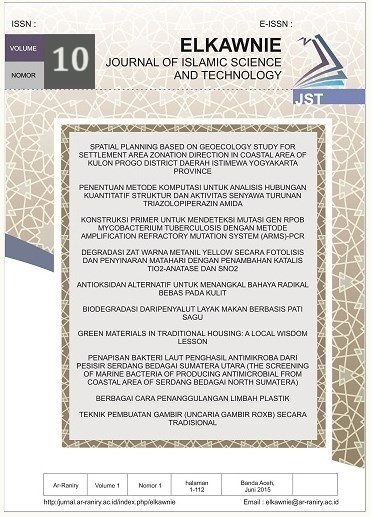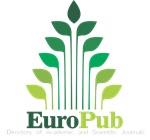Analysis of Microplastics of Bilih Fish (Mystacoleucus padangensis) in Lake Singkarak, West Sumatra Using FT-IR Spectroscopy
DOI:
https://doi.org/10.22373/ekw.v10i2.22336Keywords:
Microplastics, Digestion, Respiration, Bilih FishAbstract
Abstract: Microplastics have become a global concern due to their wide distribution and ecological effects. Understanding the interactions between microplastics and ecosystems is important for environmental risk assessment. This study analyzed the abundance and distribution of microplastics in Lake Singkarak. Substantial microplastic research is still lacking for freshwater biota, so a study was conducted to determine the level of microplastic pollution in bilih fish tissue. The fish's size, weight, and sampling point were studied about microplastic uptake through two channels, digestion and respiration. From the results, the types of polymers identified in this study were polyethylene, polyvinyl chloride, and polyethylene terephthalate. Overall, 7.14% - 23.53% (average = 11.48%) of microplastics were identified in the D tract of bilih fish from sixteen different sampling points. While 7.69% - 17.39% (average = 11.85%) of microplastics were identified in the respiration of bilih fish. The highest percentage of the abundance of microplastic forms in the digestions identified was fiber at 70.42% and 66.82% in the digestions. At the same time, The lowest percentage identified was fragmented, with an average abundance of 29.58% in digestion and 33.32% in respiration. In conclusion, this study reveals the presence and impact of microplastics in Lake Singkarak, West Sumatra, on the bilih fish (Mystacoleucus padangensis). By examining the fish's digestive and respiratory systems and using FT-IR Spectroscopy, the research highlights the ecological and economic implications of microplastic pollution. These findings emphasize the need for targeted conservation and management strategies.
Abstrak: Mikroplastik telah menjadi perhatian global karena distribusinya yang luas dan efek ekologisnya. Pemahaman tentang interaksi antara mikroplastik dengan ekosistem dinilai penting untuk penilaian risiko lingkungannya. Penelitian ini menganalisis kelimpahan dan distribusi mikroplastik di Danau Singkarak. Penelitian mikroplastik secara substansial masih sedikit untuk biota air tawar maka dilakukan penelitian untuk menentukan tingkat polusi mikroplastik pada jaringan ikan bilih. Ukuran, berat, dan titik sampling ikan diteliti dalam kaitannya dengan jerapan mikroplastik melalui dua saluran, yaitu digestif (pencernaan) dan respirasi (pernapasan). Dari hasil penelitian, jenis polimer yang teridentifikasi dalam penelitian ini adalah jenis polietilen, polivinil klorida, dan polietilen tereftalat. Secara keseluruhan 7,14% - 23,53% (rata-rata = 11,48%) mikroplastik teridentifikasi pada digestif ikan bilih dari enam belas titik sampling yang berbeda. Sementara 7,69% - 17,39% (rata-rata = 11,85%) mikroplastik teridentifikasi pada respirasi ikan bilih. Persentase kelimpahan bentuk mikroplastik tertinggi pada digestif yang diidentifikasi adalah fiber sebesar 70,42% dan 66,82% pada digestif. Sementara persentase terendah yang diidentifikasi adalah fragment dengan rata-rata kelimpahan sebesar 29,58% di digestif dan 33,32% di respirasi. Sebagai kesimpulan, penelitian ini mengungkap keberadaan dan dampak mikroplastik di Danau Singkarak, Sumatera Barat, pada ikan bilih (Mystacoleucus padangensis). Dengan memeriksa sistem pencernaan dan pernapasan ikan serta menggunakan Spektroskopi FT-IR, studi ini menunjukkan implikasi ekologis dan ekonomi dari polusi mikroplastik. Temuan ini menekankan perlunya strategi konservasi dan pengelolaan yang terarah.
References
Dzihninafira, H., Hamdan, A. M., & Razi, F. (2023). Microplastic Removal in Krueng Aceh River Water Using Ultrafiltration Membrane from Polyethersulfone Polymer (PES). IJCA (Indonesian Journal of Chemical Analysis), 6(2), 151–163. https://doi.org/10.20885/ijca.vol6.iss2.art7
Ghorbaninejad Fard Shirazi, M. M., Shekoohiyan, S., Moussavi, G., & Heidari, M. (2023). Microplastics and mesoplastics as emerging contaminants in Tehran landfill soils: The distribution and induced-ecological risk. Environmental Pollution, 324. https://doi.org/10.1016/j.envpol.2023.121368
Goodman, K. E., Hua, T., & Sang, Q. X. A. (2022). Effects of Polystyrene Microplastics on Human Kidney and Liver Cell Morphology, Cellular Proliferation, and Metabolism. ACS Omega, 7(38), 34136–34153. https://doi.org/10.1021/acsomega.2c03453
Henny, C., Rohaningsih, D., Suryono, T., Santoso, A. B., & Waluyo, A. (2022). Microplastic pollution in the surface water of Lake Singkarak, Indonesia. IOP Conference Series: Earth and Environmental Science, 1118(1). https://doi.org/10.1088/1755-1315/1118/1/012050
Hirt, N., & Body-Malapel, M. (2020). Immunotoxicity and intestinal effects of nano- and microplastics: a review of the literature. In Particle and Fibre Toxicology (Vol. 17, Issue 1). BioMed Central Ltd. https://doi.org/10.1186/s12989-020-00387-7
Husamah, & Rahardjanto, A. (2019). Bioindikator (Teori dan Aplikasi dalam Biomonitoring). Universitas Muhammadiyah Malang.
Ivleva, N. P. (2021). Chemical Analysis of Microplastics and Nanoplastics: Challenges, Advanced Methods, and Perspectives. In Chemical Reviews (Vol. 121, Issue 19, pp. 11886–11936). American Chemical Society. https://doi.org/10.1021/acs.chemrev.1c00178
Jones, J. I., Vdovchenko, A., Cooling, D., Murphy, J. F., Arnold, A., Pretty, J. L., Spencer, K. L., Markus, A. A., Vethaak, A. D., & Resmini, M. (2020). Systematic analysis of the relative abundance of polymers occurring as microplastics in freshwaters and estuaries. International Journal of Environmental Research and Public Health, 17(24), 1–12. https://doi.org/10.3390/ijerph17249304
Kovač Viršek, M., Palatinus, A., Koren, Š., Peterlin, M., Horvat, P., & Kržan, A. (2016). Protocol for Microplastics Sampling on the Sea Surface and Sample Analysis. Journal of Visualized Experiments : JoVE, 118. https://doi.org/10.3791/55161
Marine Debris Program, N. (2015). Laboratory Methods for the Analysis of Microplastics in the Marine Environment: Recommendations for quantifying synthetic particles in waters and sediments. NOAA Technical Memorandum NOS-OR&R-48.
Mohamed, M. A., Jaafar, J., Ismail, A. F., Othman, M. H. D., & Rahman, M. A. (2017). Fourier Transform Infrared (FTIR) Spectroscopy. In Membrane Characterization (pp. 3–29). Elsevier Inc. https://doi.org/10.1016/B978-0-444-63776-5.00001-2
Nousheen, R., Hashmi, I., Rittschof, D., & Capper, A. (2022a). Comprehensive analysis of spatial distribution of microplastics in Rawal Lake, Pakistan using trawl net and sieve sampling methods. Chemosphere, 308. https://doi.org/10.1016/j.chemosphere.2022.136111
Nousheen, R., Hashmi, I., Rittschof, D., & Capper, A. (2022b). Comprehensive analysis of spatial distribution of microplastics in Rawal Lake, Pakistan using trawl net and sieve sampling methods. Chemosphere, 308. https://doi.org/10.1016/j.chemosphere.2022.136111
Peixoto, D., & Pinheiro, C. (2019). Microplastic Pollution in Commercial Salt for Human Consumption: A Review. Estuarine, Coastal and Shelf Science, 161–168. https://doi.org/10.1016/j.ecss.2019.02.018
Prata, J. C., da Costa, J. P., Lopes, I., Duarte, A. C., & Rocha-Santos, T. (2020). Environmental exposure to microplastics: An overview on possible human health effects. In Science of the Total Environment (Vol. 702). Elsevier B.V. https://doi.org/10.1016/j.scitotenv.2019.134455
Revel, M., Châtel, A., & Mouneyrac, C. (2018). Micro(nano)plastics: A threat to human health? In Current Opinion in Environmental Science and Health (Vol. 1, pp. 17–23). Elsevier B.V. https://doi.org/10.1016/j.coesh.2017.10.003
Rohaningsih, D., Henny, C., Suryono, T., & Santoso, A. B. (2022). Macroplastic abundance at Lake Singkarak riparian, West Sumatera. IOP Conference Series: Earth and Environmental Science, 1062(1). https://doi.org/10.1088/1755-1315/1062/1/012025
Saad, D., Chauke, P., Cukrowska, E., Richards, H., Nikiema, J., Chimuka, L., & Tutu, H. (2022). First biomonitoring of microplastic pollution in the Vaal River using Carp fish (Cyprinus carpio) “as a bio-indicator.” Science of the Total Environment, 836. https://doi.org/10.1016/j.scitotenv.2022.155623
Su, L., Nan, B., Hassell, K. L., Craig, N. J., & Pettigrove, V. (2019a). Microplastics biomonitoring in Australian urban wetlands using a common noxious fish (Gambusia holbrooki). Chemosphere, 228, 65–74. https://doi.org/10.1016/j.chemosphere.2019.04.114
Su, L., Nan, B., Hassell, K. L., Craig, N. J., & Pettigrove, V. (2019b). Microplastics biomonitoring in Australian urban wetlands using a common noxious fish (Gambusia holbrooki). Chemosphere, 228, 65–74. https://doi.org/10.1016/j.chemosphere.2019.04.114
Su, R., & Sun, R. (2021). Editorial: Impact of climate change on the hydrological cycle. In Journal of Water and Climate Change (Vol. 12, Issue 7). IWA Publishing. https://doi.org/10.2166/wcc.2021.100
Syamsu, D. A., Deswati, D., Syafrizayanti, S., Putra, A., & Suteja, Y. (2024). Presence of microplastics contamination in table salt and estimated exposure in humans. Global Journal of Environmental Science and Management, 10(1), 205–224. https://doi.org/10.22034/gjesm.2024.01.14
Xiong, X., Tappenbeck, T. H., Wu, C., & Elser, J. J. (2022). Microplastics in Flathead Lake, a large oligotrophic mountain lake in the USA. Environmental Pollution, 306. https://doi.org/10.1016/j.envpol.2022.119445
Yuan, W., Liu, X., Wang, W., Di, M., & Wang, J. (2019). Microplastic abundance, distribution and composition in water, sediments, and wild fish from Poyang Lake, China. Ecotoxicology and Environmental Safety, 170, 180–187. https://doi.org/10.1016/j.ecoenv.2018.11.126
Zhang, C., & Wang, S. (2020). Microplastic pollution in surface water from east coastal areas of Guangdong, South China and preliminary study on microplastics biomonitoring using two marine fish. Chemosphere, 256. https://doi.org/10.1016/j.chemosphere.2020.127202
Downloads
Published
Issue
Section
License
Proposed Policy for Journals That Offer Open Access Authors who publish with the Elkawnie journal agree to the following terms:
a. Authors retain copyright and grant the journal right of first publication with the work simultaneously licensed under a Creative Commons Attribution License that allows others to share the work with an acknowledgement of the work's authorship and initial publication in this journal.
b. Authors are able to enter into separate, additional contractual arrangements for the non-exclusive distribution of the journal's published version of the work (e.g., post it to an institutional repository or publish it in a book), with an acknowledgement of its initial publication in this journal.
c. Authors are permitted and encouraged to post their work online (e.g., in institutional repositories or on their website) prior to and during the submission process, as it can lead to productive exchanges, as well as earlier and greater citation of published work (see The Effect of Open Access).

























